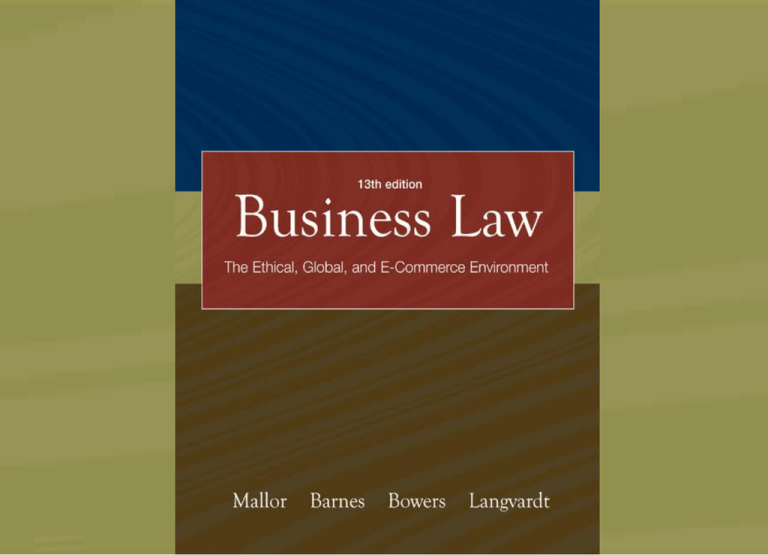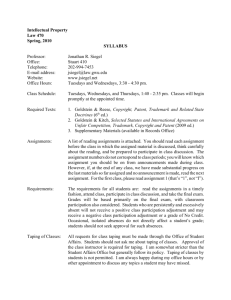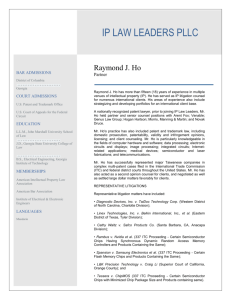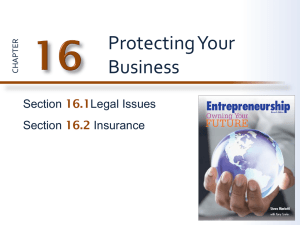
P A R T
2
Crimes & Torts
Crimes
Intentional Torts
Negligence & Strict Liability
Intellectual Property & Unfair
Competition
McGraw-Hill/Irwin Business Law, 13/e
© 2007 The McGraw-Hill Companies, Inc. All rights reserved.
C H A P T E R
8
Intellectual Property & Unfair
Competition
“I dream for a living.”
Steven Spielberg,
quoted in Time
magazine, July 1985
Learning Objectives
Infringement
of intellectual property
rights
Misappropriation of trade secrets
Unfair competition - intentional torts
Unfair competition – the Lanham Act
8-4
Types of Intellectual Property
PATENT:
Engine design,
business
methods
TRADEMARK
Logo, trade
name
COPYRIGHT
Sales materials,
artwork
8-5
Marketing materials for Case Construction Equipment
Copyright
Intangible right granted by statute to the
author or creator of certain tangible literary
or artistic productions
Can’t copyright an “idea”
Registration not required, but recommended
Applicable law: Copyright Protection Act
and the Copyright Term Extension Act
http://www.copyright.gov/
8-6
Patent
Grant from federal government to an
inventor in which inventor obtains exclusive
right to make, use, and sell his invention for
a period of 20 years (14 years for designs)
U.S. Patent Act requires registration
8-7
http://www.uspto.gov/
Patent
Protection for:
8-8
Process, a machine, a manufacture or product, a
composition of matter (such as a new chemical
compound), an improvement of any of the
above, an ornamental design for a product, a
plant produced by asexual reproduction,
certain business methods
Invention may not be patentable if it lacks
novelty, is obvious, or has no utility
Trademark
Distinctive mark, motto, device, or emblem
that a manufacturer or service provider
stamps, prints, or affixes to products it
produces or services it performs to
distinguish from those of competitors
Applicable law: Lanham Act
Registration with state or federal
government recommended, but not required
8-9
Trademark
“Trademark” applicable
to trade name, image,
logo, and dress
Trademark dilution is the
diminishment of the
capacity of plaintiff's
marks to identify and
distinguish plaintiff's
goods or services
8 - 10
Trade Secrets
Trade secret: any secret formula, pattern,
process, program, device, method,
technique, or database used in the owner’s
business that gives the owner competitive
advantage
Misappropriation of a trade secret occurs
when a person discloses or uses after
acquiring the secret
8 - 11
Infringement
Violation of intellectual property right:
when someone uses, makes, or sells
another’s trademarked, patented, or
copyrighted intellectual property without
owner’s permission, license, franchise
Penalties -- actual or statutory damages in
civil proceedings or criminal penalties for
willful violations
8 - 12
The “Fair Use” Defense
For copyright and trademark infringement, a
“fair use” defense or exception exists when
the copyrighted work or trademark is used
without the property holder’s permission
“For purposes such as criticism, comment, news
reporting, teaching (including multiple copies for
classroom use), scholarship, or research”
Section 107 of the Copyright Act
8 - 13
International Law
International intellectual property law is
governed by multilateral agreements
Paris Convention
Madrid Agreement Concerning the International
Registration of Trademarks
Madrid ProtocolWorld Trade Organization’s
Agreement on Trade-Related Aspects of
Intellectual Property Rights
See World Intellectual Property Organization
8 - 14
Commercial Torts
Intentional torts involving business include:
Injurious falsehood (product disparagement):
publication of false statements disparaging
another’s business, property, or title to
property, that harms economic interests
Intentional interference with contractual relations:
one party to a contract claims the defendant’s
interference with other party’s performance
wrongly caused plaintiff to lose the benefit of
the performance
8 - 15
Commercial Torts
Intentional interference with prospective advantage
parallels the elements for interference with
contractual relations, except prospective relations
are the focus rather than existing contracts
Section 43(a) of the Lanham Act creates civil
liability for unfair competition, including
misleading, confusing, or deceptive
representations made in connection with goods
or services
8 - 16
Test Your Knowledge
True=A, False = B
You may copyright an idea
Copyright protection requires registration
with the U.S. Copyright Office
The U.S. Patent Act requires registration of a
patent to obtain protection for the
intellectual property
The Lanham Act protects trademarks
8 - 17
Test Your Knowledge
True=A, False = B
Trademark dilution refers to the overuse
of a trademark on products or services
An employee who creates a new software
program has made a work-for-hire
The “fair use” defense is an absolute
defense to an infringement claim
8 - 18
Test Your Knowledge
Multiple Choice
A trademark refers to:
trade name
trade image
trade logo
trade dress
all of the above
Trademark dilution on the internet is
prohibited by:
8 - 19
(a)
(b)
(c)
(d)
(e)
(a) Anticybersquatting Consumer Protection Act
(b) Patent & Trademark Act
(c) Berne Convention
Thought Question
Music is intellectual
property. What do
you think about
people who download
music illegally? Have
they committed theft?
8 - 20









